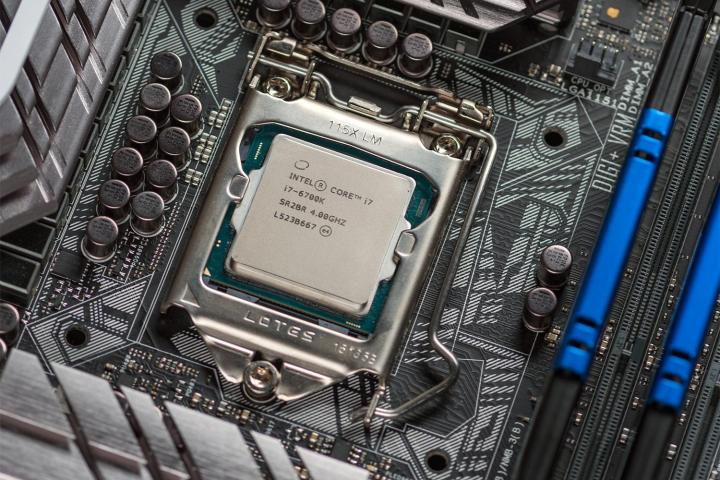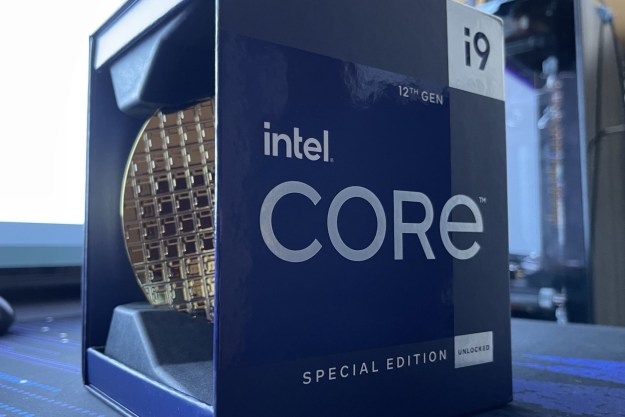
The excitement surrounding the ritual of pumping up clock speeds and voltages has been dampened as of late, however, by Intel’s rather unappreciative stance towards overclocking. It began with a gradual locking of processor multipliers which, combined with changes in architecture, has made most of the company’s chips almost impossible to overclock.
I decided to push further, and was able to complete a set of three test runs at 4.9GHz.
Then, beginning with the Ivy Bridge release (the third generation Core product line), enthusiasts began to run into disappointing overclocking results even with some “unlocked” CPUs. Despite continued improvements in efficiency, increasing the maximum clock speed has been difficult, and some reviewers achieved equal or better results with the previous generation of hardware.
Intel also missed its target with Devil’s Canyon, a 4th-generation enthusiast processor the company initially hinted could manage 5GHz on air but, in practice, often fell several hundred megahertz short of that goal.
With Skylake, however, Intel is taking steps to once again win over enthusiasts. The company launched on the desktop first, unlike its last few releases, which debuted on laptops. And Intel is boasting several changes that allegedly make aggressive overclocking easier. Is there truth to these claims? We tested the Core i7-6700K to find out.
Our test configuration
We put together a new test system to conduct our review of the Intel Core i7-6700K. It has an Asus Z170-Deluxe motherboard, eight gigabytes of Corsair Vengeance LPX DDR4 2400MHz RAM, and an Intel 730 Series 480GB SATA hard drive. It also normally includes an EVGA Superclocked GTX 980 Ti; however, we wanted to test processor overclocking in as controlled an environment as possible, so we took it out for this test.
The fan is also important to overclocking, but we didn’t go all-out. Instead we bought what I think is a solid, reasonable and affordable cooler – the Thermalrite Macho Rev.B. This giant, well-reviewed cooler fits well in our full ATX tower system and is priced at $50 online. We ran the stock fan, but used said fan at its maximum speed for the duration of our tests, which is 1300 RPM.
At its stock settings the Core i7-6700K has a base clock of 4GHz, with a rather meager maximum Turbo Boost of 4.2GHz. Its stock voltage is 1.2. The graphics component has a default maximum speed of 1150MHz, and RAM is clocked at 2133MHz. These settings provide the baseline for our test.
Putting the pedal down: Maximum processor clock speed
To begin our testing, we wanted to find the maximum stable clock speed we could obtain. Thankfully, the unlocked processor and Asus motherboard, which features Dual Intelligent Processor 5 for overclocking from within Windows, made that easy. I steadily pushed the clock up in 100MHz increments, running Geekbench through three loops each time and averaging the results.
My overclocking adventure was fortuitous.
Testing went smoothly up to 4.7GHz. At 4.8GHz, however, the processor choked within twenty seconds of starting Geekbench, and did so several times. Temperatures were well within reason, so I upped the voltage in the UEFI BIOS. Once up to 1.4V, the system was able to complete the test loop.
Then I decided to push further, and was able to complete a set of three test runs at 4.9GHz. That was only possible with the CPU Core Voltage at a whopping 1.43, which is pretty high (Asus and Intel documents recommended a maximum of 1.45V). I didn’t even try to run the processor for more than a couple Geekbench runs at that setting, since we do need our test rig to stick around for the long haul. I’m sure it would have been fine – but those are famous last words, right?
Temperatures were never an issue during our testing. Even at 1.43V and 4.9GHz, the processor hit a maximum of 68 degrees Celsius. Toasty, but still several degrees below the point where I’d start to become concerned. If I had dared to push voltage further, though, I think the Macho would’ve met its match.
Having determined that 4.9GHz was out of reach at reasonable voltage, I retreated to 4.8GHz and ran a battery of tests. This consisted of GeekBench, OCCT and 7-Zip, each of which looped for one hour. Then I ran OCCT overnight, just to be sure. I had no problems with these settings. I’m sure a slightly higher clock speed would be possible, as Skylake allows very precise changes in processor speed. However, I don’t see how working through that megahertz by megahertz would be worthwhile, and I imagine most users will feel the same.
What does an extra 800MHz mean?
There you have it — a maximum stable overclock of 4.8GHz with an air cooler. Not bad. Now what did that mean for performance?
I recorded the Geekbench test results for each 100MHz step, including the 4.9GHz test run, which I ultimately retreated from due to the high voltage required. They are graphed below. The results are about what you’d expect, with a roughly linear correlation between processor speed and Geekbench score.
The maximum safe overclock of 4.8GHz represents an exactly 20-percent increase over the base clock of 4GHz. Overclocked, the chip scored 4,586 in Geekbench’s single-score test, an 18-percent improvement over the base clock score of 3,887. The OC’ed chip also scored 19,006 in the mutli-core bench, a 20-percent improvement over the base clock score of 15,867.
That’s an extremely strong result. HardOCP managed to hit 4.7GHz stable on air, but at much higher temperatures. Overclocker’s Club managed 4.76GHz with a temperature ceiling of 72 degrees Celsius. Digital Foundry ran game benchmarks at 4.6GHz, and also managed to overclock the i7-6700K’s little brother, the i5-6600K, to 4.5GHz. Anandtech ran a variety of tests on four samples. One hit 4.7GHz, two hit 4.6GHz, and the last only managed 4.5GHz.
It should be noted that Anandtech’s worst result was from a retail, rather than engineering, sample. We used our review unit, which is an engineering sample, and the results must be viewed as only one data point among many. I did not do anything special. My air cooler is not extravagant. My methods were not unusual. I simply lucked out.
You may manage 4.8GHz as well, but it appears more realistic to expect a range somewhere between 4.5 and 4.7GHz, especially if you’re not willing to lean hard on voltage. Some have claimed an overclock on air of up to 5.2GHz. I’m fairly sure my sample could be made stable at 4.9GHz, so it’s not hard to believe a few samples might crack 5GHz, but they’ll be a small minority.
Conclusion
My overclocking adventure was fortuitous, as a clock speed increase of 20 percent is very strong. If the Core i7-6700K’s price was also increased with performance, it’d be a $420 chip. In fact, its overclocked multi-core GeekBench score comes within a few thousand points of hexa-core chips like the Core i7-5820K, though not within range of the octo-core 5960X.
It’s also worth noting that with the Asus Z170-Deluxe, at least, achieving the maximum stable overclock was a cinch. I did most of my testing from within Windows, accessing the UEFI BIOS only when I wanted to lock the chip’s voltage to 1.4V. A single, long day, followed by overnight stress testing, was all I required.
Buying a processor to overclock can be a risky proposition. With the Core i7-6700K, though, it appears to be a worthwhile endeavor. This is not only because the chip overclocks well, achieving a maximum speed somewhere between 12 and 20 percent greater than stock, but also because Skylake is quick even in stock form. It provides a small but notable bump in performance, and it’s attached to a platform that makes overclocking simple.
Overclocking is not an endeavor everyone should pursue, but if you’re interested in speed – and, in particular, maximum performance per core – overclocking the Core i7-6700K is the way to go.
Editors' Recommendations
- Gamers are reportedly returning Intel Core i9 CPUs in droves
- After 15 years, Intel may be killing the Core i5 and Core i7
- Intel’s 24-core laptop CPU might outclass desktop i9 processors
- Intel Arc Alchemist may let you overclock virtually for free
- Intel Arc A380 can be overclocked to 3.1GHz — but is it worth the effort?



